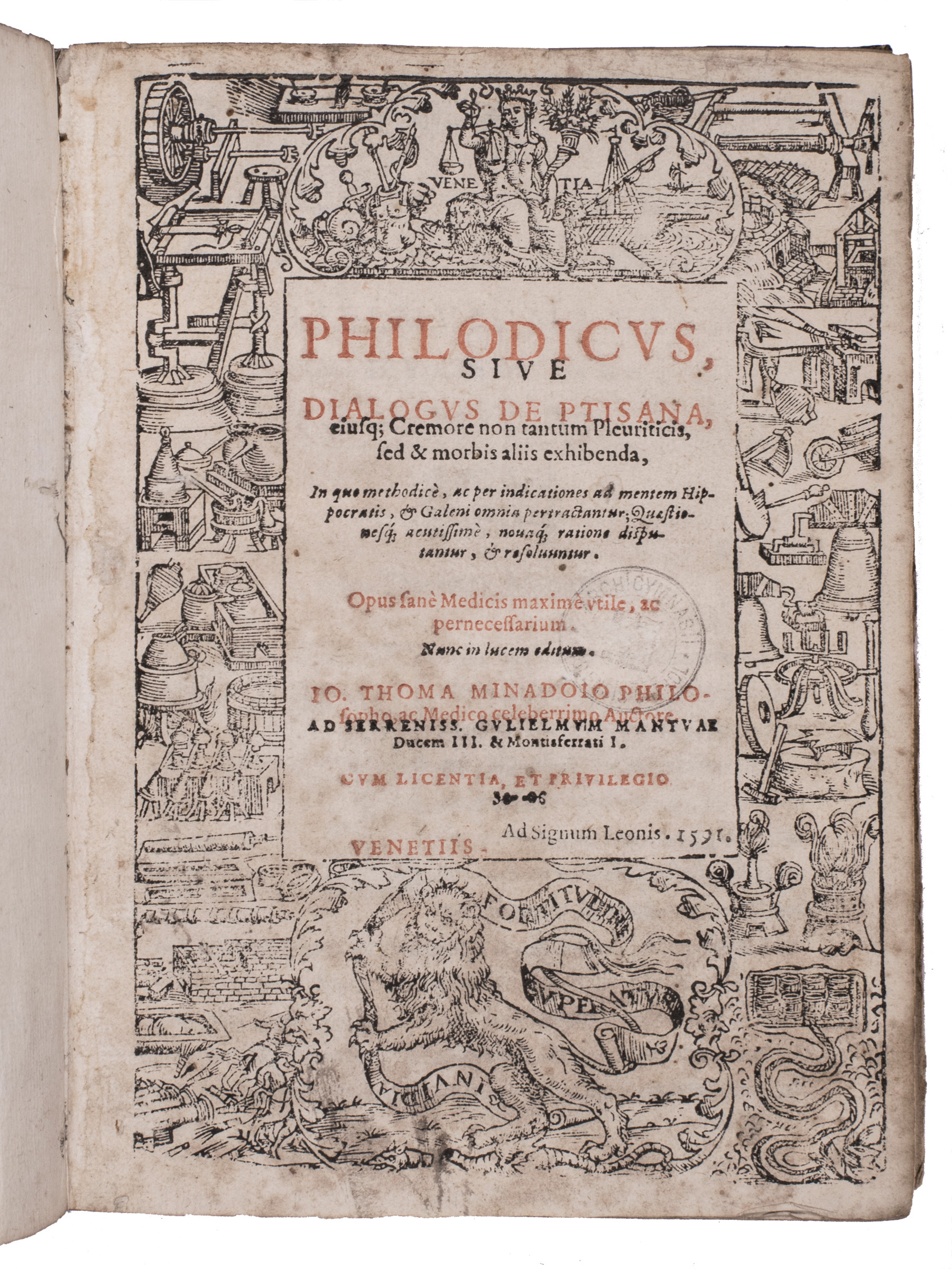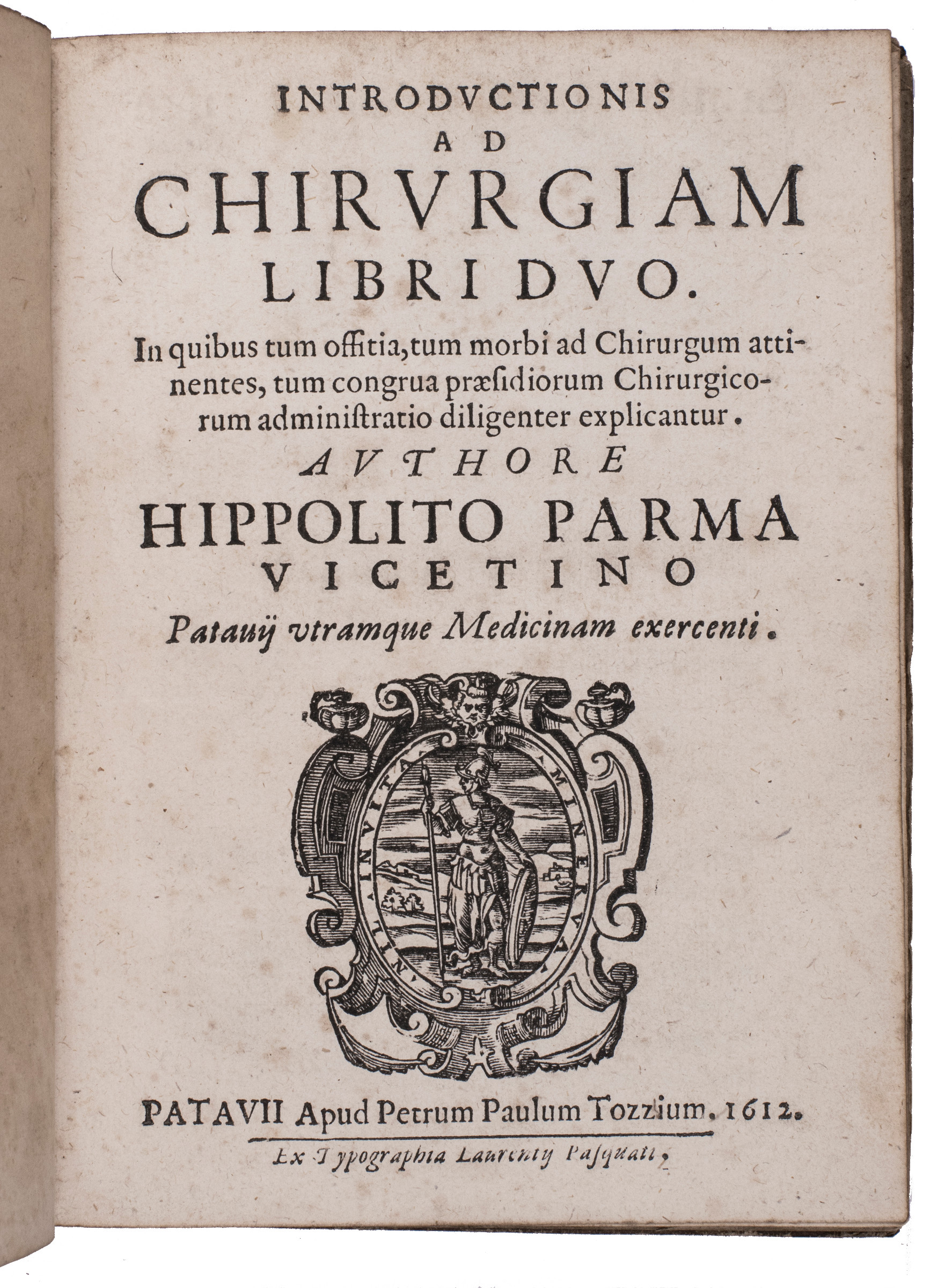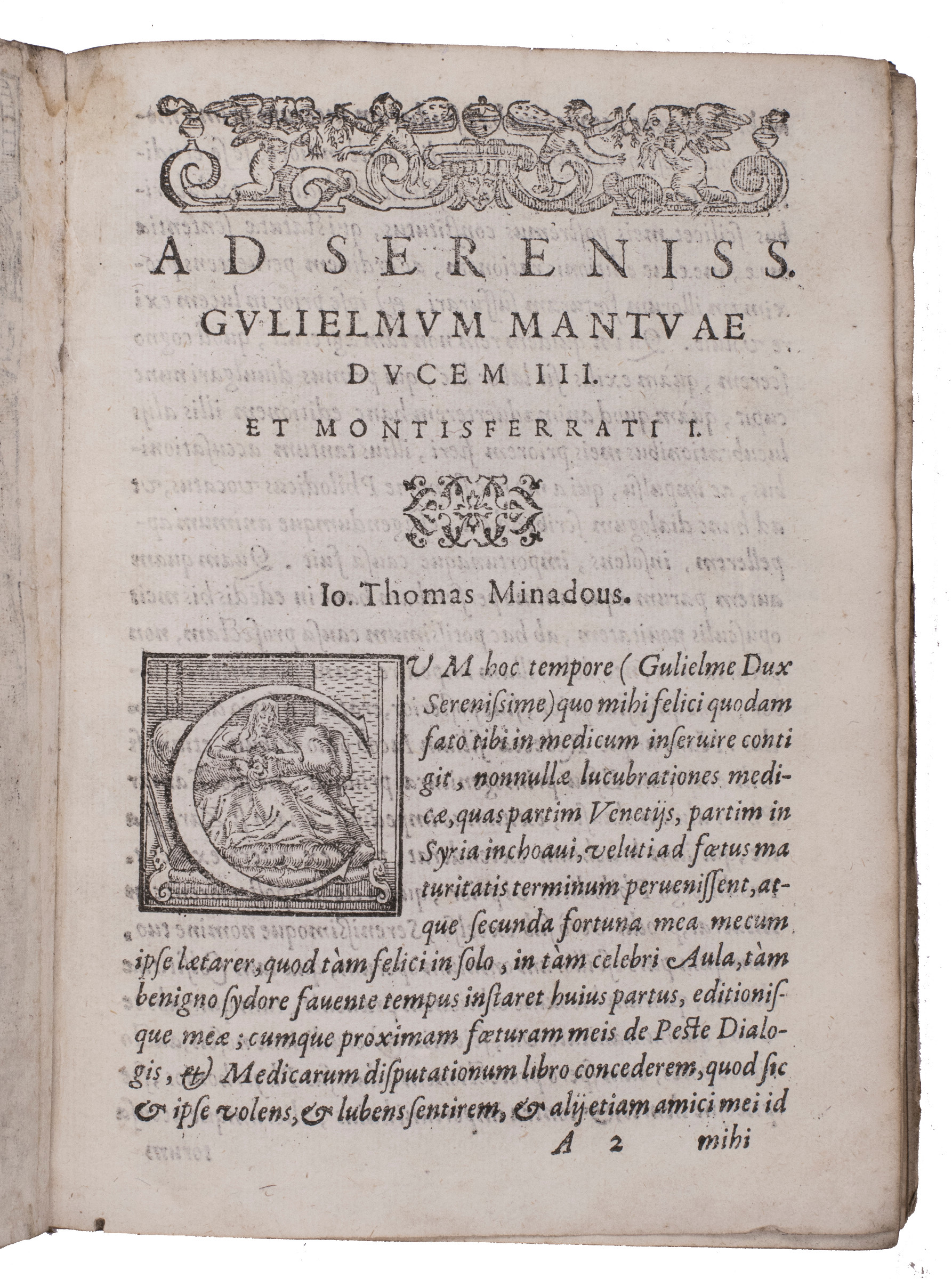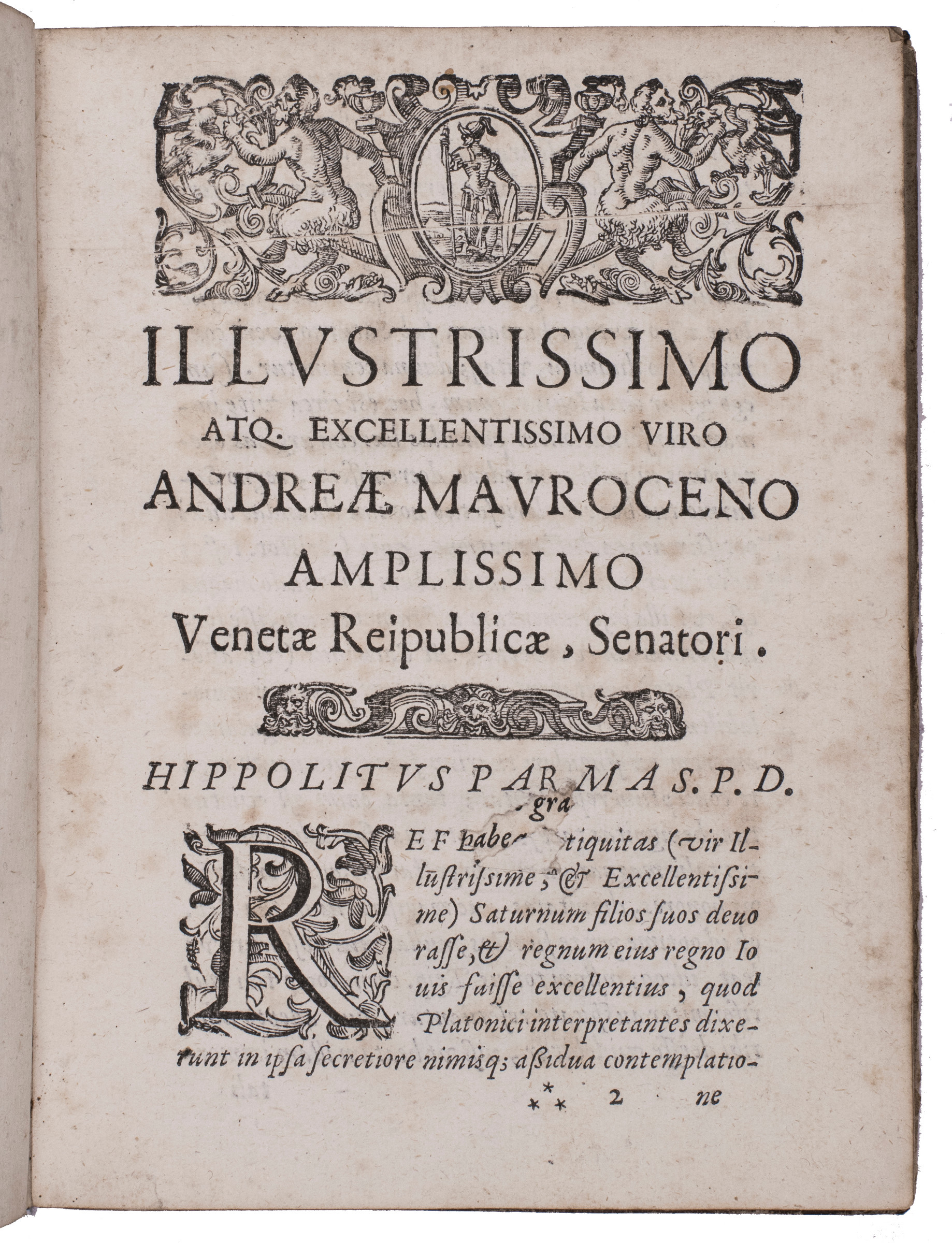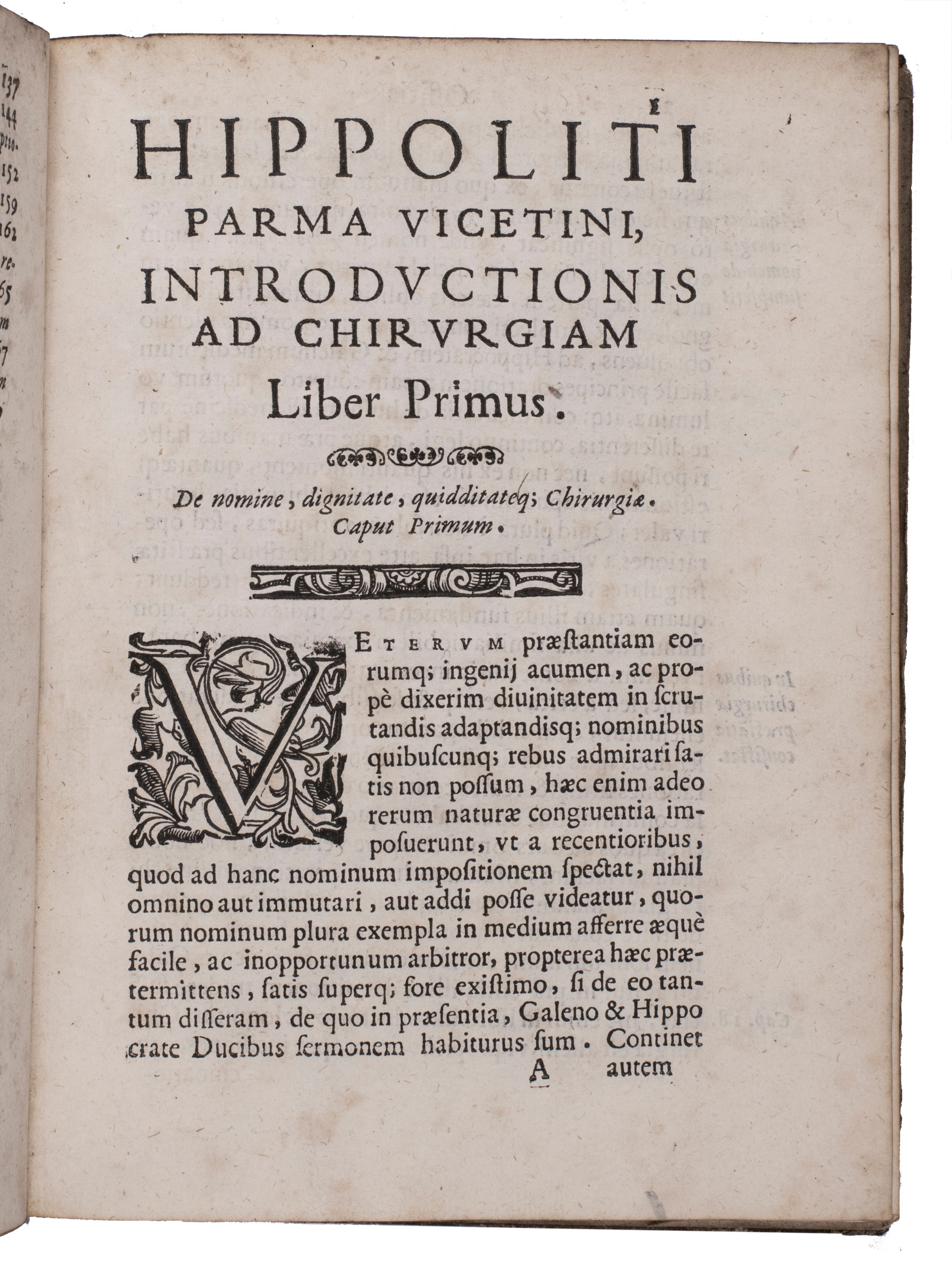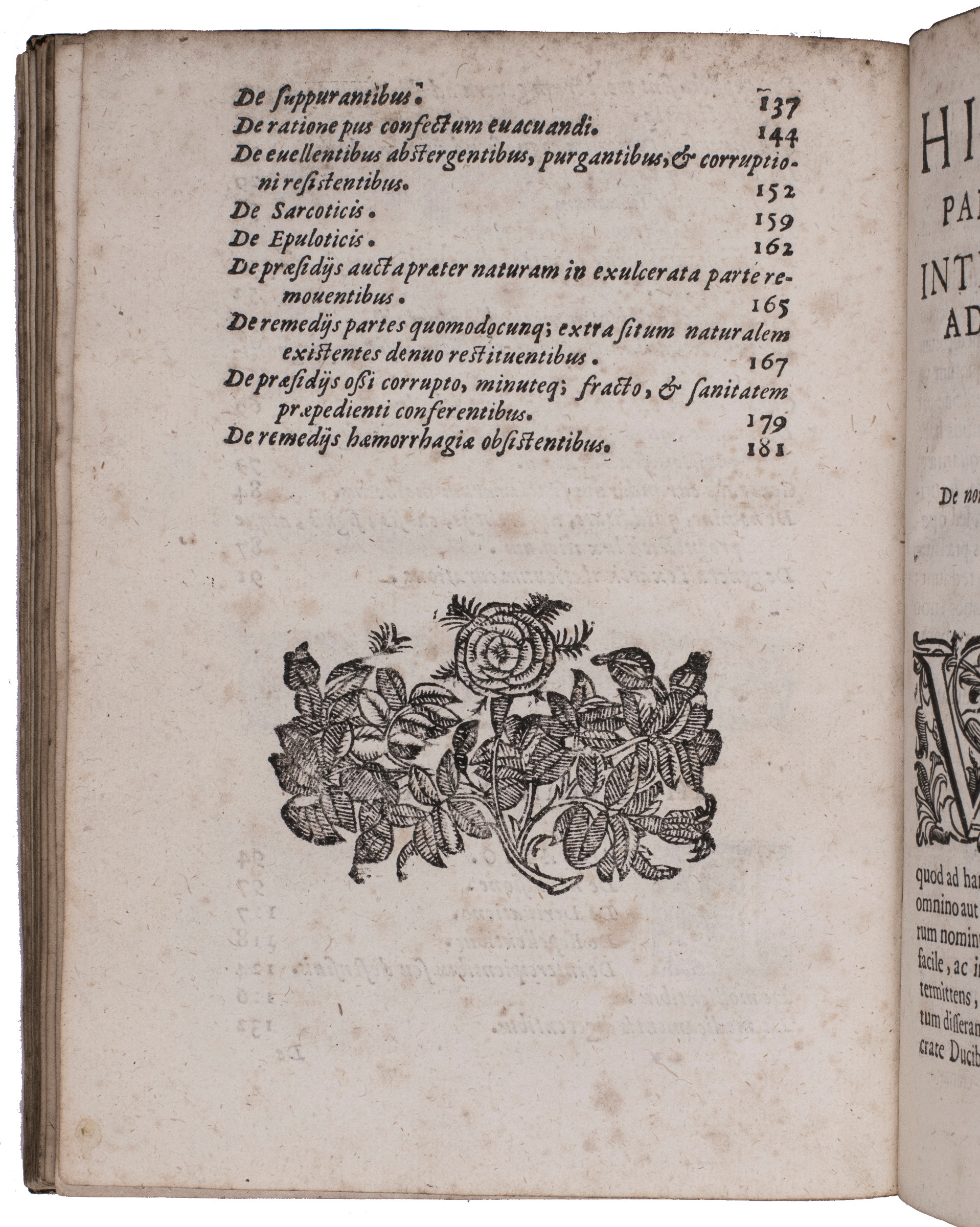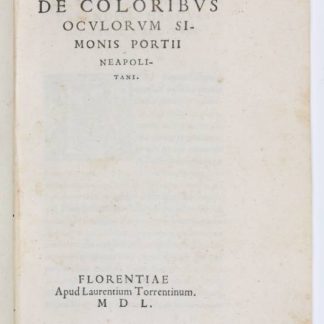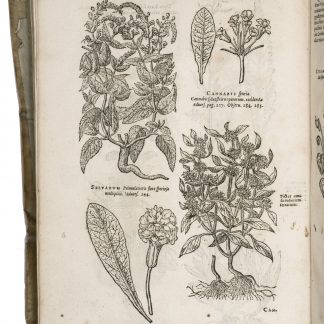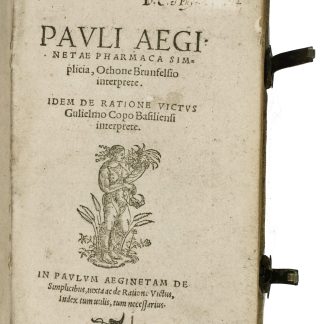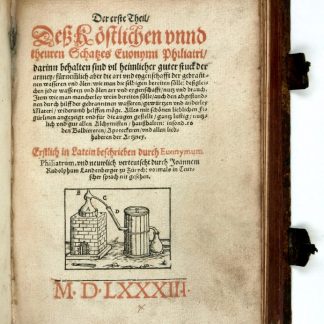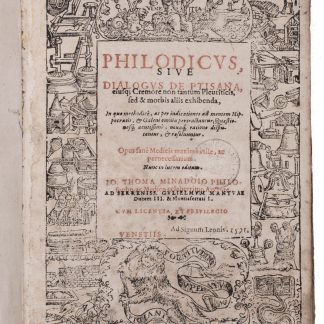Rare first editions of an Aleppo dialogue on medicinal barley infusions (1584/91) and a surgical handbook (1612)
Philodicus, sive Dialogus de ptisana [suivi de:] Introductionis ad chirurgiam libri duo.
4to. (8), 124, (2 blank); (8), 196 pp. With title-page printed in red and black in an illustrated woodcut border (showing equipment for distilling, forging and other trades plus in a cartouche at the foot Navò's rampant lion device with motto "invidia fortitudine superatur", in this case trampling a beheaded dragon, and in a cartouche at the head a scene with an allegorical female figure representing Venice), a woodcut headpiece, 4 woodcut initials with pictorial decoration (3 series), decorations built up from arabesque typographic ornaments, and a small acorn (all woodcut materials except 1 initial appear in the 1591 prelims).With: (2) PARMA, Ippolito. Introductionis ad chirurgiam libri duo. Padova, Pietro Paolo Tozzi (printed by Lorenzo Pasquato), 1612. With Tozzi's(?) woodcut Minerva device in a scrollwork cartouche on the title-page, numerous woodcut headpieces, tailpieces and other decorations, 6 woodcut decorated initials (4 series) and arabesque typographic ornaments. 2 works in 1 volume. Half calf (French, ca. 1750), sewn on 3 cords, gold-tooled spine with a tanned sheepskin (?) label (with both titles) in the 2nd of 4 compartments, plain paper sides, green headbands.
€ 12.500,00
First edition, second issue (first published in 1584) of a dialogue set in Aleppo on the use of barley infusions (often together with other medicines) for the treatment of various illnesses and ailments, written by the personal physician of the Venetian counsul to Syria and later professor of practical medicine at the University of Padova and published during his brief return to Italy between two long stays in Aleppo.
The dialogue is set at the bedside of a Venetian merchant in Aleppo who is suffering from pleurisy. Philodicus and Phioliatrus debate the proper treatment, particularly whether to administer a barley infusion before or after purging. Minadoi proposes that they continue the discussion at his house, where they can consult his extensive library. Philodicus follows the humanist Giovanni Manardo while the more conservative Philiatrus and Minadoi follow Galen. They support their arguments by citing numerous Greek, Latin and Arabic sources, including Hippocrates and Ibn Zuhr (1094-1162, known in Europe as Avenzoar). The woodcut border around the title-page of the Minadoi was originally cut for the first edition of Biringuccio's "Pirotechnia" (Venice, Venturino Roffinello for Curzio Troiano Navò, 1540). It shows a dozen or so images of equipment for distilling, forging, pyrotechnics and related trades, and incorporates Navò's lion rampant device. In the years 1591-97, Navò's heirs published without using their name, but with the present imprint "ad signum Leonis" or a variant.
Minadoi (1549?-1615), born and raised in Ferrara and Rovigo, took his degree in medicine at Padova in 1576 and went to Aleppo in 1578 as personal physician to the Venetian consul to Syria. He spent much of the next eight years there, also visiting Constantinople and Jerusalem. His experience practicing medicine in the Middle East and his contacts with the Islamic world there certainly contributed to his skill as a physician. Minadoi returned to Italy in 1586 and became city physician in Udine in 1589 but resigned in 1595. From 1596 to his death he served as professor of practical medicine at the University of Padua, though from 1612 he also spent much time at the Medici court in Florence, where he died. His scholarship was conservative, based on Galen, Hippocrates and Celsus and opposing the ideas of Paracelsus and the alchemists, but his practical experience and skill brought him great success.
Francesco Osanna, published the first edition of the present work at Mantova in 1584, dedicating it to Guglielmo Gonzaga, Duke of Mantova, who appointed him Ducal printer in 1585. Domenico and Giovanni Battista Guerra published a second edition at Venice in 1587 and the present is often described as the third and last edition. In fact, however, it is a reissue of the first edition with only the preliminary quire newly set and printed (the new preliminaries repeat the text of the dedication, even though the Duke had died in 1587). Osanna's 1584 Mantova colophon on Q3v was no longer relevant in Navò's 1591 Venice reissue, no doubt the reason that Q3 was carefully cancelled (the blank Q4 was also removed but was pasted to the stub of Q3, as one can see by the two halves of the watermark in Q1 and Q4). But the list of errata on Q3r was still relevant, and the publisher appears to have cancelled Q3 in some copies but not others (both Q3 and Q4 are cancelled in at least 2 of the 6 copies listed in ICCU).
It is bound with the first and only edition of the last and most important publication by the Padova surgeon Ippolite Parma, a practical course on surgery with a general introduction followed by treatises on tumors, surgery, broken bones, dislocations and a more general treatise on the subjects. Although Parma had published Praxis chirurgica in 1608, the present book is an entirely new work.
The endpapers show a watermark that includes the year "1749", which accords with the style of the (French) binding. With two engraved bookplates on the front paste-down, that of the Paris surgeon Sauveur François Morand (1697-1773) with medical attributes in the decoration and that of Hyacinthe Théodore Baron (1707-87), professor of medicine at the Hôtel-Dieu in Paris from 1750 to 1753 and in charge of the army medical corp, with his coat of arms (sold with his library: Catalogue de la bibliothèque de feu M. Baron, with a biography, Paris, 1788, lot 3959); circular stamp on the title-page (repeated on N3) of the Archepiscopal Gymnasium in Lille, apparently an ancestor of the 1875 Catholic University, with an open book encircled by "ARCHIGYMNASII INSULENSIS CATHOL" (the open book now forms one quarter of the University arms); and a donation inscription, dated 1881, from Alfred Dujardin to François Guermonprez (1849-1932), both medical doctors in Lille. With the last printed leaf (with the errata and 1584 colophon with the device of Osanna in Mantua) cancelled as noted, and with the final blank attached to its stub. With some minor browning (especially in quires I, K and M-Q of the Minadoi, which are printed on a different paper stock than any other quires), and occasional minor foxing or spotting. In the first quire of the Minadoi, the title-page has been re-attached and there are some small stains and restorations. There is a hole in the first page of the Parma's dedication. In spite of these minor defects, most leaves of both works are in good condition. The binding is shabby, with the front hinge cracked and two of the supports broken at that hinge, the head of the spine chipped (but the chip is loosely inserted), the sides rubbed and dirty, and some of the sewing has come loose, but most of the tooling on the spine is still clear. Two first editions on practical medicine (1584/91) and surgery (1612), with extensive provenance information.
(1): Durling 3171. Edit 16 31581. ICCU UM1E020598. Antoine Pietrobelli, "Polémiques sur la ptisane d'Hippocrate à Minadoi", in: Medicina nei secoli, 29 (2017), pp. 1077-1118, at pp. 1104-1106; USTC 842793. Cf. Adams M1458 (1587 ed.). BMC STC Italian, p. 439 (1587 ed.). Not in Garrison & Morton; Honeyman; Norman Lib.; Wellcome. For Minadoi: www.treccani.it (Dizionario biografico degli Italiani).
(2): BM-STC Italian (17th c.), p. 659. ICCU MILE004177. USTC 4023497. Not in Garrison/Morton; Honeyman; Krivatsy; Norman Lib.; Wellcome.

